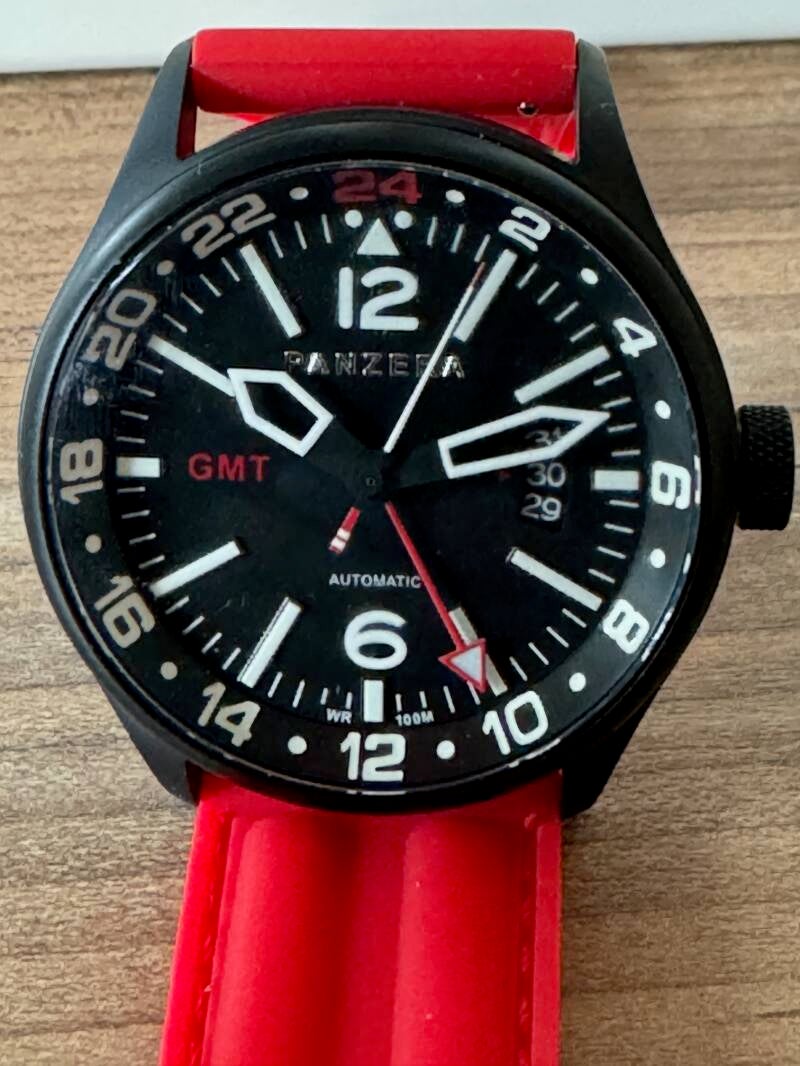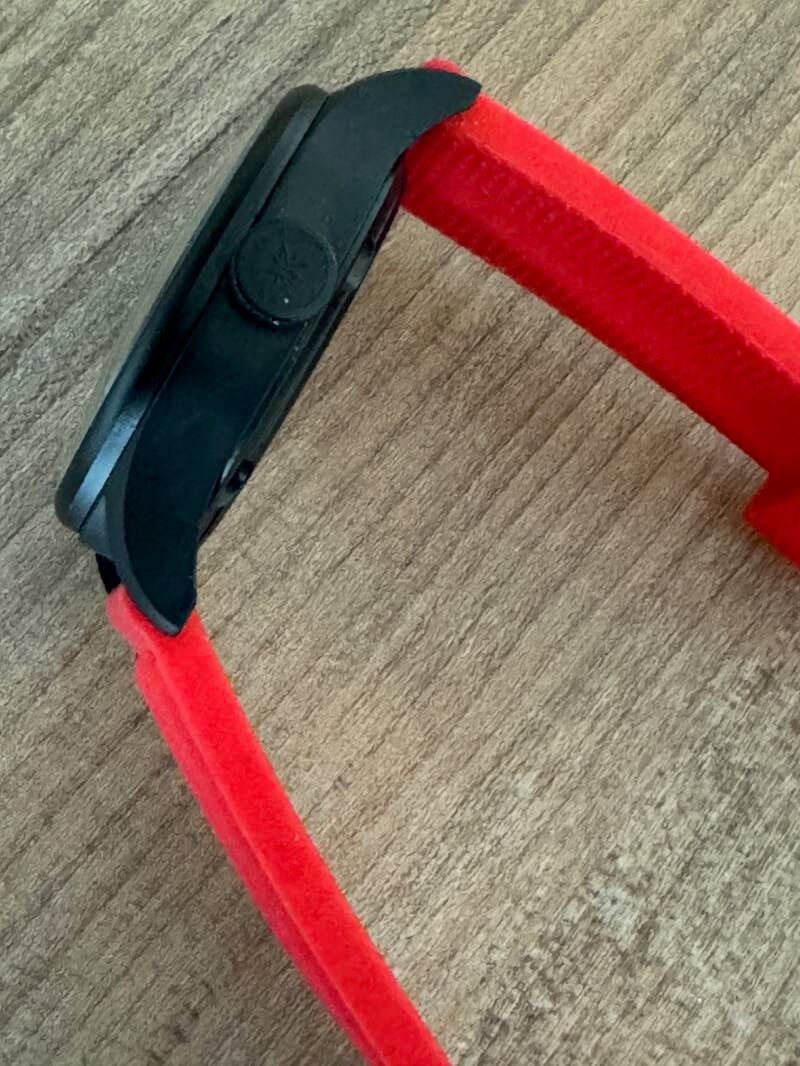

A few months ago, I published a review of two diver watches from Panzera’s Marine collection watches here.
At the end of that review, I also mentioned that I had preordered another Panzera watch—this time from the Flieger line: the new Flieger GMT model. As announced, the watch was released at the beginning of May and shipped to me shortly after. So now, after spending about a month with the Flieger GMT, I’d like to share some additional thoughts on the watch and the brand.
During the very first stage of the preorder window, Panzera offered not only a 50% discount but also a free additional strap. Since I placed my order within this first window, I received two straps of my own choosing. Based on my excellent experience with Panzera’s rubber straps from previous models, I again chose two rubber options—one in red and one in black with red stitching, both with black buckles.
As is typical for Panzera, each customer can choose their own combination of case (steel or black PVD), dial color (black, blue, or white with a blue inner chapter ring), and strap (a variety of rubber options, a steel bracelet, or several leather colors). For the PVD case, however, some dial and strap options aren’t available—for example, the white dial and steel bracelet.
Since I already have two Panzera watches with steel cases, blue dials, and blue rubber straps (one of which also has a steel bracelet), I decided it was time to go in a completely different direction. That’s the only reason I chose the black PVD case with a black dial (the white dial wasn’t available with the black case, as mentioned).
Although this watch is part of the Flieger line, at first glance it shares a surprising number of design elements with the Aquamarine 45D. In fact, it appears to have more in common with the Aquamarine 45D than the 45D has with the 45C—even though the latter two are from the same collection! The initial impression of similarity is largely due to the Panzera label below 12 o’clock, the three-day date window, the hollow hands, and the 3D inner ring.
But this first impression is deceptive. The Flieger 45G is, in fact, quite different in many important aspects. It carries the recognizable "soul" found in all Panzera watches, and that spirit may be what gives off the illusion of similarity at first.



Let’s start with the case. As the name suggests, this watch also has a 45 mm diameter, with a height of 13 mm and a lug width of 24 mm. It’s worth noting that other watches in the Flieger collection typically come in a 46 mm size, so in terms of dimensions alone, this one is actually closer to the Aquamarine collection. However, the case design is completely different from any Aquamarine model and is fully in line with the aesthetics of the Flieger series.
Overall, the case is well-executed—there are no issues with the quality of the PVD coating.


The dial is, in fact, a true Flieger-style dial—but at the same time, it’s almost identical to the basic Aquamarine 45 model, which I don’t own and therefore haven’t reviewed yet. Both reference watches are shown in the photos: the Aquamarine 45 on a red rubber strap, and the Flieger 46 on a black leather strap. I deliberately selected black PVD versions of both watches from the official website for this comparison.
Take a closer look at the fonts, index markings, hand shapes, and the signature 12 o’clock triangle with two dots above it. (Remember, this triangle-and-dot design also appeared on both the Aquamarine 45-C and 45-D models, though with a slightly different layout.)
So, all in all, the Flieger 45G is a Flieger in almost every detail—except for the font of the red “GMT” text, which isn’t taken from the Flieger line but instead from the Aquamarine.
That detail, however, brings up a broader issue: it’s clear that Panzera still struggles a bit with defining what exactly the Aquamarine line should look like, and what defines the Flieger line. The inconsistency is more evident within the Aquamarine collection, where we see very different case designs, hand shapes, and even variations in the triangle marker at 12 o’clock.
But let’s return to the Flieger 45G we’re reviewing here. As mentioned, it follows the core Flieger design language very closely, so there’s nothing inherently "wrong" in terms of visual identity. What makes this watch stand out from the more basic Flieger models is the 3D inner ring with 24-hour markings—a distinctive and functional addition.
The watch is fitted with a sapphire crystal with anti-reflective coating, and despite being a Flieger-style piece, it offers a solid water resistance of 100 meters.
Overall, I have no serious complaints about the dial design—aside from the broader design inconsistencies inherited from earlier models across the two lines. If I focus solely on this watch, I’d say the index markings are a bit too long and aggressive for my taste, which makes the dial feel slightly overcrowded. The hands are also on the wider side.
That said, what I really do appreciate is the subtle use of red—on the “24,” “GMT,” the GMT hand, and the lower part of the second hand. These small accents were exactly why I chose the rubber straps I did. In my opinion, both straps tie together the black case, the black dial, and those red highlights into one very attractive-looking watch.

The lume—Illuminova—is good; I believe it’s the same as used on the Aquamarine models. My only issue here, again, is that too much is illuminated for my personal taste.
So, all in all, it’s quite a nice combination of design and build quality. Well… until we get to the movement.
The 45G has an open caseback, revealing the Seiko NH34A movement with a GMT complication. If you recall, I already reviewed another watch with this movement— the Waldhoff Atlas. In that watch, the NH34 wasn’t particularly precise, but here the results are even worse—and in the opposite direction.
The positional accuracy varies significantly. The watch runs anywhere from approximately +10 to +35 seconds per day, and even when left in the same position, it doesn’t maintain a consistent rate. Sometimes, the variation extends even further—from –5 to +45 seconds daily! In practical terms, this means that when worn continuously on the wrist, the watch averages around +20 seconds per day.
These are the worst results I’ve recorded among all the watches I’ve reviewed. Honestly, even some of my old USSR watches—with far less sophisticated movements—would be able to compete with this.
Of course, we need to be fair: the Seiko NH34 belongs to the lower tier of their movement lineup (part of the NH3x family), and its official accuracy range is an astonishing +40/-20 seconds per day (!!). So technically, my results are still within the declared range. Still, I believe Panzera could have done a better job fine-tuning the movement—at least adjusting it to shift the average rate closer to neutral, say –5 seconds instead of +20.
So, unfortunately, the generally very positive impression of the watch is seriously undermined by the poor performance of its movement.
Wearing the watch brings no surprises—in the best possible sense. As expected, it’s very comfortable on the wrist, and the case size is not an issue at all. Although it shares the same 45 mm diameter as both Aquamarine models, the Flieger has a slightly shorter lug-to-lug distance, which makes it easier to wear for a wider range of watch enthusiasts.
In my previous review, I praised Panzera’s rubber straps, and these two are from the same family—so excellent quality was expected, and once again, that expectation was fully met.
Since the watch arrived in the same type of leather box as the Aquamarine 45D, I’ll skip the packaging and paperwork description this time.
Now, the price. When Panzera first announced the preorder phase, this watch was promoted as “the cheapest automatic GMT watch on the market.” The official price now ranges from €545 (steel case with rubber strap) up to €720 (steel case with bracelet). The black PVD case is slightly more expensive than the steel one, and leather straps cost more than rubber but less than a bracelet. On top of that, you need to factor in import taxes, customs, and shipping. So, for EU buyers, the total price climbs to somewhere between €700 and €900, depending on local VAT.
And that’s far from being the cheapest automatic GMT watch on the market—and definitely well above what I would consider a realistic price for any watch powered by a Seiko NH3x movement. The previously mentioned Waldhoff Atlas, for example, is significantly cheaper. But as already explained in my previous Panzera review, the brand has a rather unpredictable pricing policy, with frequent promotions offering up to 40% off. So, with a bit of luck and good timing, you can drastically reduce the official price. Only then does this watch qualify as one of the most affordable automatic GMT watches available.
However, this lower price is achieved at the cost of using a movement with very poor accuracy. Just for comparison, OrologiChePassione currently offers “my” exact configuration for €580, VAT included. That’s essentially the official price, but this time with VAT already factored in.
During the preorder phase, Panzera offered a 50% discount and an additional strap for free. In the end, my complete package—with shipping, customs, and taxes included—came out to just over €400. Considering that a rubber strap alone costs €72 (plus tax), I still believe that was a fair deal. But those times are gone.
And at the current official price, even though the watch is well-built and visually attractive, I cannot recommend it. What I concluded in my last review has once again proven true here: Panzera’s official prices are too high for the quality they provide. But at the realistic price—after applying one of their frequent deep discounts—Panzera watches fall into a more appropriate price bracket that makes them competitive and worth considering.
One final recommendation: if you're interested in a Panzera watch, go for one with a Swiss movement. I now have two Panzera watches powered by Seiko movements, and both have had issues—either a (surprisingly) non-functional movement in the 45D or (somewhat expected) poor accuracy in the 45G. Just bad luck? Perhaps.






Add comment
Comments